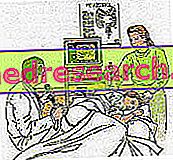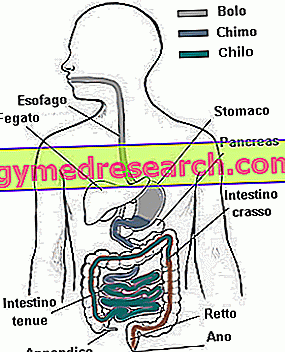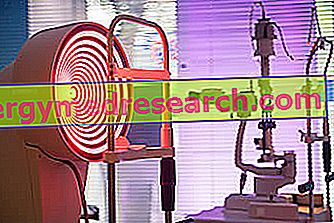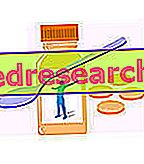Generality
Erythema nodosum is an inflammatory disease of the skin, characterized by the appearance of red nodules on certain anatomical areas of the body. The target of the disease is subcutaneous fat cells.

In some cases the disease has an indefinite origin, while in others it is linked to particular pathological conditions.
The diagnosis of erythema nodosum is quite simple, because the pathological signs are clear and unequivocal.
Except when the symptoms are particularly intense, healing takes place without special treatments and within 6-8 weeks.
Once they have disappeared, the nodules leave no scars or other signs of their passage.
What is erythema nodosa?
Erythema nodosum is a dermatological disease of an inflammatory nature. In particular, inflammation affects subcutaneous fat cells, triggering the appearance of red-colored nodules on the skin. The consistency of these nodules is at first rigid and then soft.
The cutaneous regions that are usually covered with nodules are the tibias ; however, many other areas of the body, such as the arms, neck, face, legs and trunk, are potentially at risk.
IT'S A PANNICULITE
The erythema nodosum is considered a panniculitis ; in fact, according to medical language, the panniculitis are proper of the inflammatory processes that involve the subcutaneous adipose tissue.
Epidemiology
Erythema nodosum is the most common form of panniculitis. However, according to an Anglo-Saxon statistical study, it is a rare disorder, which affects 2-3 individuals every 10, 000 people annually.
Although it can arise at any age, usually erythema nodosum prefers young subjects, aged between 20 and 35 years. Women are more at risk: in fact, the ratio of women to men is 6 to 1.
Causes
Erythema nodosum may arise without a specific reason ( idiopathic erythema ) or for well-defined reasons ( secondary erythema ).
IDIOPACTIC NODOUS ERYTEMA
In medicine, a disease is defined as idiopathic when it arises without an identifiable reason.
The idiopathic form of erythema nodosum is very frequent: in fact, it affects 30-50% of people affected by this inflammatory skin disease.
SECONDARY KNOT ERYTEMA
In medicine, a disease is associated with the secondary term when it appears as a consequence of a particular condition, pathological or otherwise.
Secondary erythema can arise from a variety of causes. It is usually preceded by a streptococcal infection or an autoimmune disease known as sarcoidosis; however, it can also derive from other types of infections, other autoimmune diseases, some forms of cancer, a state of pregnancy and, finally, the combination of some drugs.
The complete picture of the conditions that can trigger a secondary erythema is reported in the table below.
- Streptococcal infection with beta-hemolytic streptococcus group A. This bacterium loves to live on the surface of the skin and inside the throat. According to some reliable studies, streptococcal infection of group A is one of the main causes of secondary erythema in the child.
- Sarcoidosis . It is an autoimmune disease, which causes a generalized inflammatory state (ie extended to all organs of the body). It is characterized by the presence, in various anatomical regions, of proliferating masses called granulomas.
- Tuberculosis . Caused by a bacterium called Koch's bacillus, tuberculosis is a serious infectious and contagious disease that usually affects the lungs.
- Chlamydia . Belonging to the category of sexually transmitted diseases, chlamydia is the infection caused by the bacterium Chlamydia trachomatis .
- Infection with Mycoplasma pneumoniae . This bacterium triggers a very common form of pneumonia among children and young adults.
- Infection with Yersinia enterocolitica . Yersinia enterocolitica is the name of a bacterium that triggers an inflammatory process in the intestine. The typical symptoms of this form of enterocolitis are diarrhea and abdominal pain.
- Salmonella infection . Salmonella is a small bacterium that causes a food poisoning known as salmonellosis. A classic symptom of salmonellosis is gastroenteritis.
- Campylobacter infection . Campylobacter is a genus of bacteria that causes campylobacteriosis, a food-borne infection similar to salmonellosis.
Because of diarrhea and abdominal pain, campylobacteriosis is one of the most common gastrointestinal bacterial diseases in the world.
- Combination of drugs . Medicines that, if associated with each other, can trigger erythema nodosum are sulfonamides, penicillin derivatives and the contraceptive pill.
- Ulcerative colitis . It is an autoimmune disease, which belongs to the category of so-called inflammatory bowel diseases. It affects the large intestine and causes abdominal pain and diarrhea.
- Crohn's disease . It is an autoimmune disease, which, like ulcerative colitis, belongs to so-called inflammatory bowel diseases. It can affect any part of the digestive system, but usually affects the small intestine and the colon. Its typical symptoms are diarrhea and abdominal pain.
- Pregnancy .
- Lymphomas and leukemias . Lymphomas are called tumors that originate in the lymphatic system, while leukemias are called blood cell tumors.
But why does pregnancy or chlamydia cause the appearance of erythema nodosum only in certain individuals? In other words, what change or pathological process does it trigger in these people who do not occur in others?
According to doctors and researchers, the aforementioned conditions cause erythema nodosum only if the subject's immune system is, for some unknown reason, altered and more sensitive than normal to certain events.
The immune system is the shield that an organism (human or animal) uses against threats from the external environment. Sometimes, in some people, it may inexplicably suffer alterations and respond in an unusual way to the occurrence of certain circumstances.
Symptoms and Complications
Erythema nodosum begins with flu-like symptoms and joint problems. A few days after the appearance of these first signs, red nodules (the so-called rash or skin rash ) form on the patients' skin ; these lesions are initially of rigid and painful consistency, then they become much softer and less annoying.
SIMIL-INFLUENCIAL SYMPTOMS
The flu-like manifestations that characterize erythema nodosum are generally: fever, cough, asthenia, malaise, abdominal pain, and loss of body weight . As mentioned, they are the first signs of the disease.
PROBLEMS TO JOINTS
Along with flu-like symptoms, individuals with erythema nodosum may experience joint pain, stiffness and swelling . Among these, the most affected are the hips, knees and wrists, although potentially all the major joint joints in the human body can be involved.
Joint problems can last several weeks (from about 6 to about 8).
RASH OR SKIN EXAMPLE
The rash, or skin rash, is the most characteristic pathological sign of erythema nodosum. It consists in the appearance, on the skin, of nodules of variable dimensions (2-6 centimeters), initially bright red, warm, stiff and painful.

The skin rash is usually bilateral (but not symmetrical) and lasts about 6 weeks; in this period of time, the number of nodules that can be formed is considerable.
The tibias represent the most affected anatomical area, but the nodules can potentially arise anywhere, therefore also on the skin of legs, arms, trunk, neck and face.
IF THE NODOUS ERITEMA IS DUE TO A PATHOLOGICAL CONDITION
When the erythema nodosum is due to a pathological condition, for example a bacterial infection, its symptoms appear together or slightly after those of the latter.
From the diagnostic point of view, it is important to understand the triggering disease (the type of infection, the type of tumor, etc.), because only then can the right therapeutic treatment be undertaken.
WHEN TO REFER TO THE DOCTOR?
Very often the erythema nodosum resolves without specific treatment. Nevertheless, it is advisable to contact the doctor anyway, to clarify the form (whether idiopathic or secondary) and the precise causes of the disease. Furthermore, maximum attention must be paid to the evolution of the symptoms and to the persistence of the characteristic signs.
COMPLICATIONS
On some rare occasions and without a specific reason, the nodules can last longer than expected or become a recurrent, almost chronic disorder.
These are the only known complications, related to erythema nodosum, that deserve to be reported.
Diagnosis
Diagnosing erythema nodosum is quite simple, especially for an experienced doctor, as the pathological signs are obvious and unequivocal.
However, often, in addition to the physical examination (during which the symptoms and signs of the disease are analyzed), more or less invasive laboratory tests are needed, aimed at finding out what caused the appearance of erythema nodosum.
As mentioned above, understanding the causes of the onset of erythema nodosum allows the doctor to better plan the therapeutic treatment.
In case of doubts concerning the nature of the nodules, a skin biopsy may be necessary.
BIOPSY
The biopsy involves the collection, through an incision made on the exanthematic area, of a small portion of skin tissue and the observation of this under a microscope.
If, to the instrument, the cells that show the typical signs of ongoing inflammation are the adipose cells, it means that it is actually a erythema nodosum.
Biopsy is the only diagnostic test that can establish the nature of the nodules with some degree of confidence.
LABORATORY AND INSTRUMENTAL TESTS
Regarding laboratory and instrumental tests, depending on the suspected diagnosis, the doctor may request the execution of:
- A pharyngeal swab . It is a very quick and simple test, which involves the collection, using a cotton bud, of a sample of pharyngeal mucosa. Subsequently, this tissue is analyzed in the laboratory. The analysis serves to identify any pathogenic bacteria, such as group A beta hemolytic streptococcus.
- Blood analysis . They are used to trace various types of infectious agents.
- An RX-thorax (or chest radiograph) . It is performed in cases of suspected tuberculosis.
- A tuberculin skin test (or Mantoux test or tuberculin intradermal reaction) . It is the most frequently performed test in case of suspected tuberculosis. It consists in injecting, in the patient's forearm, a white substance called tuberculin, which, in the case of tuberculosis, causes the appearance of swellings and small patches at the injection site after 48 hours.
- A stool test .

- A colonoscopy . It is useful if Crohn's disease or ulcerative colitis is suspected. It provides for the insertion, via anale, of a small camera (the colonoscope), which allows to "see" the state of health of the internal walls of the large intestine.
Treatment
The erythema nodosum tends to resolve spontaneously (ie without specific treatment), within 6-8 weeks.
To accelerate healing, or to alleviate a particularly marked symptomatology, it is possible to resort to some therapeutic remedies, such as resting, taking anti-inflammatory drugs (NSAIDs and corticosteroids), potassium iodide, cold-damp compresses on painful areas etc.
If the erythema nodosum is secondary, it is essential that the treating physician plans an adequate therapy for the triggering causes.
HOW TO RELIEVE THE SYMPTOMS
To speed up healing, rest is essential, cover the painful areas with cold-damp compresses and, when the nodules are on the legs or arms, apply protective bandages .
If the symptoms are unusually marked, to alleviate them, it is possible that the doctor prescribes the patient:
- Potassium iodide . It is a particular medicine that, taken orally, mitigates joint pain, that caused by nodules and fever.
- Non-steroidal anti-inflammatory drugs (or NSAIDs) . They are drugs of discreet power and effectiveness, capable of reducing both the inflammatory state and the sense of pain. The most indicated NSAIDs for erythema nodoso are naproxen, indomethacin and aspirin (NB: aspirin should not be administered in subjects under the age of 16 due to the possible onset of Reye's syndrome ). The main side effects are: nausea, vomiting and dyspepsia.
- Corticosteroids . They are powerful and effective anti-inflammatory drugs, but at the same time also dangerous; therefore, they should only be taken on medical advice and for limited periods of time. In cases of erythema nodosum, local administration (ie direct application on exanthematic areas) is preferred; on the contrary, if taken by mouth, they can dangerously mask the symptoms of a serious bacterial infection.
- Colchicine . Colchicine is an alkaloid of natural origin, which has good effects on joint pain.
Beware of corticosteroids
Corticosteroid drugs should be taken with care and attention following the doctor's instructions; if used improperly they can in fact cause serious side effects, such as hypertension, increased body weight, osteoporosis, glaucoma, diabetes and muscle weakness .
CAUSE OF CAUSES
If the erythema nodosum is secondary, the doctor must prescribe a specific cure against the triggering causes. This means, to cite a couple of examples, that the nodular erythemas caused by a bacterial infection require a therapeutic treatment based on antibiotics, while the nodular erythemas caused by an autoimmune disease (such as ulcerative colitis or Crohn's disease ) may require an immunosuppressive therapy (ie based on the intake of drugs that suppress the immune system).
Prognosis
Except for complications, erythema nodosum heals in 6-8 weeks, without leaving scars or other traces of its passage.




